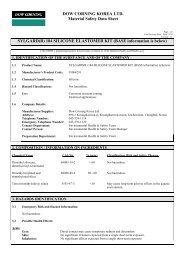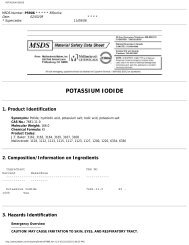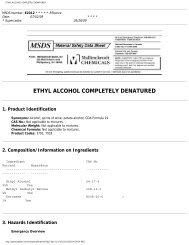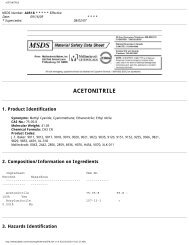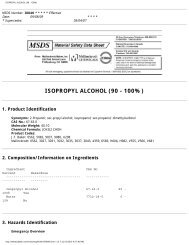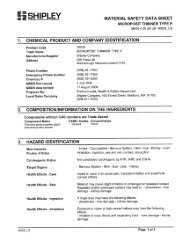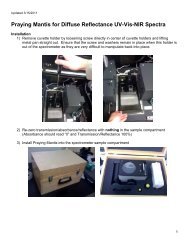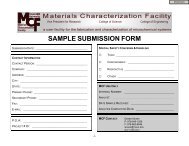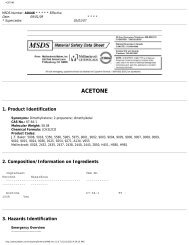Fomblin Y-LVAC 25/6
Fomblin Y-LVAC 25/6
Fomblin Y-LVAC 25/6
- No tags were found...
You also want an ePaper? Increase the reach of your titles
YUMPU automatically turns print PDFs into web optimized ePapers that Google loves.
<strong>Fomblin</strong> Y-<strong>LVAC</strong> <strong>25</strong>/6<br />
Page 1 of 5<br />
<strong>Fomblin</strong> Y-<strong>LVAC</strong> <strong>25</strong>/6<br />
SOLVAY SOLEXIS, Inc.<br />
10 Leonards Lane<br />
Thorofare, NJ 08086<br />
856-853-8119<br />
Section 1 - Chemical product and Company information<br />
Date Revised: December 30, 2002<br />
Product Name: <strong>Fomblin</strong> Y-<strong>LVAC</strong> <strong>25</strong>/6<br />
Chemical Name: Propene, 1,1,2,3,3,3-hexafluoro, oxidized, polymerized<br />
Chemical Family: Fluorocarbons, Perfluorinated polyethers<br />
Synonyms: None<br />
Emergency Telephone: 800-424-9300 (CHEMTREC, 24 hours)<br />
856-853-8119<br />
Emergency Overview:<br />
Clear, colorless liquid. Thermal decomposition will generate hydrogen fluoride (HF), which is corrosive.<br />
Section 2 - Compositional information<br />
Name:<br />
Propene, 1,1,2,3,3,3-hexa- fluoro, oxidized,<br />
polymerized<br />
CAS#<br />
69991-67-9 100<br />
Approximate Weight<br />
(% wt.):<br />
Section 3 - Potential Health Effects<br />
Effects of Overexposure:<br />
Eye Contact<br />
Eye contact may cause slight irritation.<br />
Skin Contact<br />
Skin contact may cause slight irritation.<br />
Inhalation<br />
Inhalation of vapors or mists may cause respiratory tract irritation.<br />
Ingestion<br />
Not an expected exposure route. Ingestion may cause nausea and vomiting.<br />
Section 4 - First Aid Measures
<strong>Fomblin</strong> Y-<strong>LVAC</strong> <strong>25</strong>/6<br />
Page 2 of 5<br />
Eye Contact:<br />
Flush eyes for 15 minutes with copious amounts of water, retracting eyelids often. Seek medical<br />
attention if irritation persists.<br />
Skin Contact:<br />
Wash skin thoroughly with mild soap and water. Flush with lukewarm water for 15 minutes.<br />
Inhalation:<br />
If symptoms of irritation, discomfort or overcome by exposure, remove affected person to fresh air. Give<br />
oxygen or artificial respiration as needed.<br />
Ingestion:<br />
If conscious, drink three to four 8 ounce glasses of water or milk. Call a physician. If unconscious,<br />
immediately take affected person to a hospital. Do not give anything by mouth to an unconscious<br />
person.<br />
Section 5 - Fire Fighting Measures<br />
Flash Point: Not Applicable<br />
Lower Explosive Limit: Not Applicable<br />
Upper Explosive Limit: Not Applicable<br />
Autoignition Temperature: Not Applicable<br />
Extinguishing Media: Water (spray or fog), foam, dry chemical or carbon dioxide (CO2).<br />
Unusual Fire Hazards:<br />
Fluoropolymers will degrade upon prolonged heating or in a fire, liberating carbonyl fluoride and<br />
hydrogen fluoride (HF). This gas is toxic if inhaled or it comes into contact with moist skin. HF has an<br />
ACGIH TLV ceiling limit of 3 ppm (2.6 mg/m3) and an OSHA PEL TWA of 3 ppm. Carbonyl fluoride<br />
has an ACGIH TLV TWA and OSHA PEL TWA of 2 ppm (5 mg/m3).<br />
Fire Fighting Procedures:<br />
Use self contained breathing apparatus (SCBA) and skin protection for acid gas exposure. Do not enter<br />
fire area without proper protection. Fight fire from a safe distance. If possible, air monitoring should be<br />
performed.<br />
Section 6 - Accidental Release Measures<br />
Releases:<br />
In case of a release or spill, absorb material onto vermiculite or similar inert absorbent. Use<br />
Perfluorosolv0 PFS1 Solvent to clean any residual material. Place spilled material into covered container<br />
for disposal. Dispose of according to applicable local, state and federal regulations. Extinguish all<br />
ignition sources and evacuate the area. Exercise caution; spill area may be slippery.<br />
Section 7 - Handling and Storage
<strong>Fomblin</strong> Y-<strong>LVAC</strong> <strong>25</strong>/6<br />
Page 3 of 5<br />
Wash hands after use and before handling food or applying cosmetics. Do not use tobacco products in<br />
the immediate area. Keep containers closed. Keep away from heat, sparks and flames. Do not store near<br />
combustible materials.<br />
Section 8 - Exposure Controls/Personal Protection<br />
ACGIH Threshold Limit Value (8hr. time weighted average)<br />
None established<br />
OSHA Permissible Exposure Limit Value (8hr. time weighted average)<br />
None established<br />
Engineering Controls:<br />
Ventilation Requirements:<br />
Local Exhaust: Vent vapors or mists generated by processing away from operating personnel. Local<br />
exhaust ventilation at a rate of 50 feet per minute.<br />
Personal Protective Equipment:<br />
Respiratory Protection:<br />
No occupational exposure standards have been developed for this material. In situations where exposure<br />
to vapors or mists is likely, NIOSH/MSHA approved respirators are recommended. Respirator use<br />
limitations made by NIOSH/MSHA or the manufacturer must be observed. Respiratory protection<br />
programs must be in accordance with 29 CFR 1910.134.<br />
Eye Protection:<br />
Eye/Face Protection: ANSI Z87.1 approved safety glasses with side shields or equivalent.<br />
Skin Protection:<br />
Rubber or latex gloves recommended but not necessary.<br />
Section 9 - Physical and Chemical Properties<br />
Appearance: Clear liquid<br />
Color: Colorless<br />
Odor: Odorless<br />
Vapor Pressure: Not available<br />
Vapor Density (Air=1): Not available<br />
Boiling Point: Not available<br />
Melting Point: Not available<br />
Specific Gravity: 1.7 - 1.9<br />
Solubility in Water: Insoluble<br />
Molecular Formula: CF3-[(O-CF-CF3-CF2)n-(O-CF2)m]-O-CF3<br />
Molecular Weight: Not available<br />
% Volatile by Volume: 0<br />
Section 10 - Stability and Reactivity
<strong>Fomblin</strong> Y-<strong>LVAC</strong> <strong>25</strong>/6<br />
Page 4 of 5<br />
Stability:<br />
This material is stable.<br />
Reactivity:<br />
This material is not reactive.<br />
Conditions to Avoid:<br />
Heat, sparks, flames, and other ignition sources; avoid heating above 290o C/554o F.<br />
Materials to Avoid:<br />
Strong or non-aqueous alkali or Lewis acids above 100o C/212o F.<br />
Hazardous Decomposition Products:<br />
Thermal decomposition of this product will generate hydrogen fluoride (HF), which is corrosive,<br />
causing burns on contact with skin and other tissue.<br />
Incompatibility (Materials to Avoid):<br />
Alkali metals and halogenated compounds.<br />
Section 11 - Toxicological Information<br />
Rat oral LD50: greater than <strong>25</strong>.65 g/kg<br />
Rat intraperitoneal LD50: greater than <strong>25</strong> g/kg<br />
Rat dermal LD50: greater than 2 g/kg<br />
Rabbit skin irritation: not irritating<br />
Rabbit eye irritation: not irritating<br />
Guinea pig sensitization: not a sensitizer<br />
Section 12 - Ecotoxicological Information<br />
No ecotoxicological information is available for this material.<br />
Section 13 - Disposal Considerations<br />
Waste Disposal: Material, as supplied, is not a hazardous waste. Landfill according to current federal,<br />
state and local regulations, or incinerate in a high-temperature incinerator designed to burn fluorinecontaining<br />
materials. Processing, use or contamination may make this information inaccurate or<br />
incomplete.<br />
Section 14 - Transportation information
<strong>Fomblin</strong> Y-<strong>LVAC</strong> <strong>25</strong>/6<br />
Page 5 of 5<br />
Shipping Class: Not regulated by DOT.<br />
Section 15 - Regulatory information<br />
All components of this product are listed on the Toxic Substances Control Act (TSCA) Section 8(b)<br />
Chemical Inventory and the Canadian Environmental Protection Act (CEPA) provisional domestic<br />
substances list (DSL). This product is not a "hazardous substance" as defined by OSHA Hazard<br />
Communication Standard (29 CFR 1910.1200). This product is not a "controlled product" as defined by<br />
the Canadian Workplace Hazardous Materials Information System (WHMIS).<br />
SARA Section 302 Extremely Hazardous Substances:<br />
Not listed<br />
SARA 311/312:<br />
Acute: No<br />
Chronic: No<br />
Fire: No<br />
Reactivity: No<br />
Sudden Release of Pressure: No<br />
SARA Section 313 Toxic Chemicals:<br />
Not listed<br />
Section 16 - Additional Information<br />
NFPA Ratings (Scale of 0-4):<br />
Health=1<br />
Fire=0<br />
Reactivity=0<br />
To our knowledge, the information contained herein is accurate as of the date of this document.<br />
However, neither Solvay Solexis Inc. nor any of its affiliates makes any warranty, expressed or implied,<br />
or accepts any liability in connection with this information or its use. This information is for use by<br />
technically skilled persons at their own discretion and risk and does not relate to the use of this product<br />
in combination with any other substance or any other process. This is not a license under any patent or<br />
other proprietary right. The user alone must finally determine suitability of any information or material<br />
for any contemplated use, the manner of use and whether any patents are infringed. This information<br />
gives typical properties only and is not to be used for specification purposes.<br />
Copyright 2002, Solvay Solexis, Inc. All Rights Reserved.



